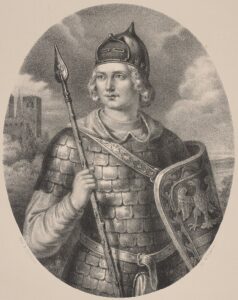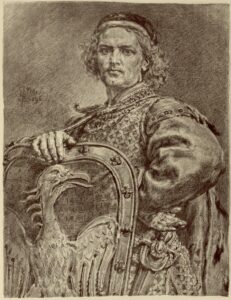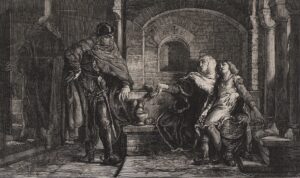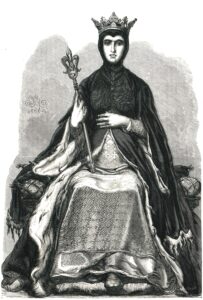At the end of 1227, a congress was held in Gąsawa with the participation of Leszek the White (son of Casimir II the Just), the most powerful of the contemporary Piast dukes. This congress was simultaneously the last meeting in the life of the princeps, who was then murdered in a bestial manner. Who ordered the assassination of the Cracow duke? Who gained the most from Leszek’s death and what consequences did it bring to Poland?
The Death of Leszek the White in Sources
Leszek the White was one of the few ducal rulers who had a chance to unify Poland, which since the entry into force of the infamous testament of Bolesław III Wrymouth (1138) had been divided into duchies. Thanks to favorable agreements, Leszek managed to attract his former rivals, Henry the Bearded and Władysław Spindleshanks, to his side. With the latter, the Cracow duke even concluded a survivorship agreement, which created the prospect of incorporating his lands (Greater Poland) into Leszek’s realm.
Ultimately, however, the work of unifying Poland was squandered because in 1227 Leszek the White died in tragic circumstances in Gąsawa, having lived just over 40 years. The duke’s final moments were described in detail by Jan Długosz, based on the „Greater Poland Chronicle”. According to this chronicler, Świętopełk, ruler of Pomerania and Leszek’s vassal, was responsible for Leszek the White’s death. In light of earlier sources, Duke Władysław Odonic of Kalisz was also involved in the princeps’s assassination.
In Cracow circles, a tradition was even cultivated about Leszek being killed solely by Władysław („Calendar of Cracow Cathedral”, „Chronicle of the Cracow Chapter”). Only later Lesser Poland sources („Chronicle of Traska”, „Chronicle of Dzierzwa”) considered Świetopelk guilty of Leszek’s death, from which Jan Długosz, writing in the 15th century, took this information.
Sources created in Silesia presented a similar course of events. According to the „Compiled Silesian Chronicle”, Leszek the White died at the hands of the Pomeranians. Another Silesian source, the „Polish-Silesian Chronicle”, saw among the regicides the Pomeranians and Władysław Odonic cooperating with them.
In the „Galician-Volhynian Chronicle”, an account nearly contemporary to the events, we also read about the murder of Casimir the Just’s son by Władysław Odonic and Świętopełk. This source is very important for our considerations because it was created outside Poland, and its author was not emotionally involved in Piast power struggles, nor was his intention to whitewash or blame any side of the conflict.
From all the written sources presented above, it follows conclusively that Władysław Odonic and Świętopełk of Pomerania were guilty of the death. Why did they decide to attempt the princeps’s life?

Dangerous Allies
The agreement concluded in 1218 between Leszek the White and Władysław Spindleshanks was directly aimed at the latter’s nephew, Władysław Odonic, who aspired to assume rule over all of Greater Poland. Ultimately, the second Władysław’s intentions did not come to fruition because he was expelled by his uncle to Hungary.
In the Árpád state, however, the exile did not stay very long, finding shelter at the court of Świętopełk of Pomerania. As specialists indicate, around 1220 Odonic married the sister of the Gdańsk duke, Hedwig, with whom he had two sons: Przemysł and Bolesław. On this occasion, as was customary in those times, a close agreement was concluded between father-in-law and son-in-law. Although we do not know its conditions, from the development of later events historians deduce that Świętopełk committed to supporting the Piast duke in his return to Greater Poland. In turn, Władysław declared his support for his father-in-law in actions resulting in independence from the Piasts and the creation of an independent duchy in Gdańsk Pomerania.
On October 9, 1223, Władysław Odonic with his ally invaded the duchy of Władysław Spindleshanks and captured the poorly guarded Ujście on the Noteć River. As some researchers indicate, the attackers did not stop at this success, because soon after they struck at Nakło, located east of Ujście, which also fell into their hands. Faced with the enemy’s advances, Spindleshanks decided to sign a peace treaty with his nephew in Kcynia (November 30, 1223), guaranteeing him possession of the castellanies of Ujście and Nakło.

As we can see, Odonic achieved a lightning victory in a very short time. From the conquered lands he made himself a launching base against his uncle’s duchy, which he intended to take over. The decisive clash between the warring sides came in 1227. Władysław Spindleshanks attacked first, beginning the siege of Ujście, where Odonic had shut himself in. However, the siege operations were conducted sluggishly, so the prospect of the besiegers capturing the stronghold receded with each day of the war. To make matters worse, the younger of the Władysławs suddenly left the stronghold on July 15, 1227, and struck at his uncle’s positions. An open field battle then ensued, lost by Spindleshanks. As a result of the victory, Odonic took possession not only of Ujście, but also later of Poznań, Kalisz, and other centers.
Under these conditions, Władysław Spindleshanks had no choice but to turn for help to his allies: Henry the Bearded and Leszek the White, who had so far passively observed the changes taking place in Greater Poland. As historians noted, Spindleshanks’ rival’s recent achievements were not to Leszek’s advantage because they disrupted the then-functioning system of alliances and the resulting balance of power.
Significantly, Leszek also could not bear the fact that Władysław Odonic’s ally, Świętopełk, had changed his seal at the beginning of 1227 (the image of a lily appeared, symbolizing independent monarchical power) and his titulature (from official to ducal). All these gestures undermined the then legal-political order in Poland.
The Congress in Gąsawa
The resolution of conflicts along the lines of Leszek the White – Świętopełk and Władysław Spindleshanks – Władysław Odonic was to take place still in 1227 at a congress in Gąsawa, near Żnin, where the most important Piast dukes of the era were to gather. The beginning of the congress, as Jan Długosz noted, took place on St. Martin’s Day, that is, November 11.
To this day, it has not been established who came up with the idea of organizing the all-Polish meeting. Most often mentioned in this context was Władysław Spindleshanks, who had had enough of struggling with his hated nephew. It is also possible that the congress would not have come about without the clear initiative of Leszek the White, who as supreme duke intended to mediate in all disputed matters between the ducal rulers.
In historiography, the hypothesis periodically returns that the dukes gathered at the Gąsawa assembly were not so much to deliberate there as to set out against Świętopełk and force him into submission. Against the proposed hypothesis speaks primarily the late time of year, which evidently did not favor undertaking such armed initiatives. There were even scholars who believed that an open field battle took place near Gąsawa, in the course of which Leszek the White met his death. However, this is too far-reaching a conjecture and, moreover, one that finds no reflection in the available source material.
The presence of clerical persons in Gąsawa also seems to contradict the theory of taking any military steps against Swietopelk in 1227. In light of the sources, Archbishop Vincent of Niałek of Gniezno, Bishop Paul of Poznań, Iwo Odrowąż of Cracow, Lawrence of Lubusz, Michael of Włocławek, Bishop-elect Gunter of Płock, and numerous secular and clerical magnates deigned to come to the Greater Poland stronghold.
See also: The Third Queen of Poland – The Wife of Bolesław the Generous
In Gąsawa – besides Leszek the White and Władysław Spindleshanks – Henry the Bearded and Conrad of Masovia also appeared. Presumably, Casimir of Opole did not bother to come to Greater Poland, as he was little drawn to participate in the country’s political life during the period in question. The assembled dukes and magnates were only waiting for the arrival of two men: Władysław Odonic and Świętopełk of Pomerania.

The Course of the Talks
From the beginning of the Gąsawa congress, semi-official and official talks on current political topics took place. A particularly strongly discussed issue must have been the matter of the Greater Poland conflict that had been dragging on for several years, but its amicable settlement was connected with the physical appearance of Władysław Odonic in Gąsawa.
It is not known, however, whether Świętopełk was invited to Greater Poland, who was most likely guaranteed personal immunity in exchange for taking part in the deliberations. As historians emphasize, the presence of the most important ecclesiastical hierarchs at the congress indicates that the problem was taken seriously, and the negotiations conducted were intended to be crowned with some concrete arrangements, which were certainly planned to be sworn to, as was done on many similar occasions.
During breaks between deliberations, they probably chatted about lighter topics. After all, the passing days had to be somehow managed while waiting for the father-in-law and son-in-law who were delaying their arrival. It was once suggested that the bored Piasts entertained themselves with heavily alcoholic feasts and baths in the bathhouse, where they treated their hangovers. Whether this was really the case cannot be determined today due to the lack of sources, which by some strange coincidence completely omitted the matter of the course of the Gąsawa talks.
Over time, impatience among the assembled dukes and magnates increased. They could not understand why Władysław Odonic and Świętopełk were late for the deliberations, especially since the former lived very close to Gąsawa. Finally, some of the Piast dukes decided to return home. Among them were Władysław Spindleshanks and Conrad of Masovia. It is not excluded that upon departure they agreed to undertake another round of talks in the future on disputed matters that were ultimately not resolved in Gąsawa. In historiography, one can also encounter the view that Leszek the White proposed organizing an expedition to Gdańsk Pomerania in spring 1228, during which they intended to defeat Świętopełk and make him dependent on the princeps again. Which of these variants ultimately prevailed, we can only guess. The only certainty was that the Gąsawa congress ended in failure, and Leszek, as its actual organizer, decided to be among the last to leave the Greater Poland stronghold.

The Bloody Gąsawa Crime
If Leszek the White had decided to set out for Lesser Poland a little sooner, his life would most likely have taken a completely different course. Unfortunately, this ultimately did not happen. On the morning of November 24, 1227, the Cracow duke was unexpectedly attacked by a group of assailants who found him in the bathhouse, where he was taking a bath.
The moment of attack was chosen excellently by the bandits, because the ducal camp was practically undefended and seriously weakened as a result of the departure from Gąsawa of most of the dukes and magnates who had been assembled there earlier. It is possible that the conspirators had their spies at the place of deliberations, who kept them informed about the development of the situation. They decided to attack in the morning, when the vigilance of the knights defending the ducal camp was decidedly at its lowest.
See also: Who was Dobroniega Maria, the wife of Casimir the Restorer?
The attackers were spotted at the last moment, which made it impossible to organize an effective defense. Besides, how could one defend oneself naked, when the only weapons available to the attacked were the implements found in the bathhouse. Fortunately, Leszek the White managed somehow to jump on a horse and gallop on its back toward Gniezno. Perhaps he counted on the attackers not pursuing him, and that he would find the desired shelter in the Gniezno stronghold?
Meanwhile, not all those attacked had as much luck as Leszek the White. Most of them were cut down on the spot by the assassins, who had no mercy for anyone. By some miracle, Duke Henry the Bearded of Silesia escaped death, who due to his advanced age was too weak to repeat the feat of Leszek, who was decidedly younger than him. At the last moment, the faithful knight Peregryn of Wiesenburg saved his lord’s life by covering the seriously wounded duke with his own body.
The Bestial Death of Leszek the White
Despite his earnest efforts, Leszek the White did not manage to reach Gniezno. The group of riders pursuing him relentlessly caught up with him in the village of Marcinkowo, only two kilometers away from Gąsawa. It is assumed that the fair-haired duke was leaving tracks in the snow because he had been wounded earlier, which greatly facilitated the task of the aggressors who were to kill him. Although historians sometimes tried to defend the attackers, suggesting that they only intended to kidnap Leszek, their behavior testifies to something completely different.
At a certain moment, the increasingly weakening Leszek the White was no longer able to stay in the saddle and fell from his horse. The cutthroats could now calmly catch the wounded and chilled princeps, but ultimately they decided to finish him off, cutting him mercilessly with their spears and swords. Leszek was therefore murdered in a bestial manner. In one moment, the then most powerful candidate for Polish king died.
See also: Pereyasłava – Mother of the Masovian Piasts
The body of the slain Leszek was then transported to Cracow and buried in Wawel Cathedral on December 6, 1227. On his final journey, the duke was accompanied by his wife, Duchess Grzymisława, and their one-year-old son, Boleslaw the Chaste, who by force of circumstances could not remember his father. A magnificent tomb was built for Leszek, which was already dismantled in the 14th century on the orders of Cracow Bishop Nanker, who erected a new church in place of the dismantled mausoleum.
Bibliography:
- Chrzanowski M., Leszek Biały, książę krakowski i sandomierski, princeps Polonia (ok. 1184-23/24 listopada 1227), Kraków 2013.
- Labuda G., Śmierć Leszka Białego (1227), „Roczniki Historyczne” 61 (1995).
- Pelczar S., Władysław Odonic, Książę wielkopolski, wygnaniec i protektor Kościoła (ok. 1193-1239), Kraków 2013.
- Przybył M., Władysław Laskonogi, Poznań 2015.
- Semkowicz A., Zbrodnia gąsawska, „Ateneum, Pismo Naukowe i Literackie” 3 (1886).
- Smoliński M., Świętopełk Gdański, Poznań 2016.
- Teterycz-Puzio A., Zamachy na Piastów, Poznań 2019.
Author: Mariusz Samp